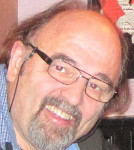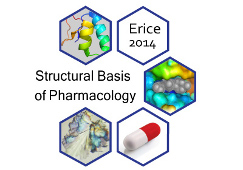 Eddy Arnold
Eddy Arnold
Governors Professor of Chemistry and Chemical Biology
Rutgers University,
Piscataway, NJ (USA)
Arnold@cabm.rutgers.edu
|
| Starting in 1987 my laboratory at Rutgers University and the Center for Advanced Biology and Medicine has worked to understand the structural and molecular basis of human infectious disease problems and to apply the insights gained to the development of better treatments. We have been particularly interesting in understanding the structure and function of viral polymerases and cellular RNA polymerases, and using this information to drive design of new therapeutics.
1. HIV/AIDS. A central topic of our studies has been reverse transcriptase (RT), an essential component of the AIDS virus and the target of many of the most widely used anti-AIDS drugs. Using the techniques of X-ray crystallography, our team has solved the three-dimensional structures of HIV-1 RT in complex with antiviral drugs and segments of the HIV genome. These studies have illuminated the working of an intricate and fascinating biological machine in atom-by-atom detail and have yielded numerous novel insights into polymerase structure-function relationships, detailed mechanisms of drug resistance, and structure-based design of RT inhibitors. Our crystal structures enabled the discovery and development of two drugs (etravirine/TMC125 and rilpivirine/TMC278), currently being used for treating HIV infection, that have exceptional potency against drug-resistant variants. We are continuing to study the molecular basis of HIV RT function, inhibition, and resistance, and are pursuing additional avenues for molecular targeting of HIV RT, including development of RNase H inhibitors as potential drugs. Recent success in protein and crystal engineering yielding high-resolution crystals of HIV-1 RT (diffracting in some cases to 1.5 Å resolution) has enabled a systematic application of crystallographic drug-like fragment screening, revealing several novel allosteric sites for inhibiting RT polymerase and RNase H activity. Recent work applying crystallographic fragment screening to HIV-1 integrase has revealed novel chemical scaffolds for allosteric inhibition of HIV-1 IN (ALLINIs).
2. Bacterial disease targets including tuberculosis and MRSA. With the laboratory of Richard Ebright we are studying structures of bacterial RNA polymerase—the central transcription machinery and a validated target for treatment of tuberculosis. Among the key structures analyzed are T. thermophilus RNA polymerase complexes with antibiotics streptolydigin and myxopyronin, and an open-promoter complex that has revealed the structural basis of transcription initiation.
3. Influenza virus. My laboratory has also focused on developing a better understanding of the molecular basis of influenza virus pathogenesis, and applying our expertise in structural biology and drug design to developing novel flu drugs targeting the viral polymerase. Several years ago we initiated crystallographic fragment screening against the cap-snatching endonuclease of 2009 H1N1 pandemic influenza A virus. We succeeded in identifying drug-like fragments that bound to the endonuclease active site, chelated the catalytic metal ions, and inhibited enzymatic activity. Working with medicinal chemist Edmond LaVoie we undertook a structure-based optimization effort to evolve a fragment with initial IC 50 of 16 micromolar to a lead compound that inhibits the enzyme at 11 nanomolar concentration, and the lead compound was shown to have anti-influenza activity by collaborator Luis Martinez-Sobrido at the University of Rochester Medical Center. We are continuing to use this structure-based drug design platform to create derivatives of the most potent 3-hydroxypyridinone lead that will have improved activity in thwarting influenza virus infection.
Eddy Arnold is Board of Governors Professor of Chemistry and Chemical Biology at Rutgers University and a Resident Faculty Member at the Center for Advanced Biotechnology and Medicine. He has authored more the 240 scientific publications. Among his awards and honors are two NIH MERIT Awards (1998-2008, 2009-2019) and the Hyacinth Award “Honoring Advances in the Struggle Against AIDS” (2013). He is an elected Fellow of the American Association for the Advancement of Science (2001) and in the American Academy of Microbiology (2006). |
 Joseph D.Bauman Joseph D.Bauman
Assistant Research Professor
Rutgers University, Piscataway NJ, (USA)
bauman@cabm.rutgers.edu
|
| Joseph D. Bauman, PhD, is an assistant research professor at Rutgers University under the mentorship of Eddy Arnold. Dr. Bauman has over 10 years of experience in protein engineering for crystallography, which he has used to create variants of drug targets for high-throughput crystallography. He has executed structure-based drug design projects against the viral polymerases of HIV-1 and influenza polymerases. His current work focuses on applying X-ray crystallography for fragment-based drug discovery and subsequent lead development. |
 Helen M. Berman
Helen M. Berman
|
| HELEN M. BERMAN received her Ph.D. in Chemistry in 1967 from the University of Pittsburgh under the direction of George Alan Jeffrey, and stayed on for postdoctoral training as a National Institutes of Health Trainee. In 1969, she joined the Fox Chase Cancer Center, where her research program focused on nucleic acid crystallography. In 1989, she joined the faculty at Rutgers, The State University of New Jersey, where she is now a Board of Governors Professor of Chemistry and Chemical Biology. At Rutgers, she studied collagen and protein-nucleic acid complexes in addition to nucleic acids, and at the same time developed structural databases and ontologies. As head of the Research Collaboratory for Structural Bioinformatics (RCSB), Berman became the Director of the Protein Data Bank (PDB) in 1998, and was a founding member of the Worldwide Protein Data Bank (wwPDB) collaboration in 2003. The wwPDB supports scientific research and education worldwide by providing the essential PDB archive of information about the experimentally-determined structures of proteins, nucleic acids, and complex assemblies. Other biological data management projects include EMDataBank, a global deposition and retrieval network for 3DEM map, model, and associated metadata, and the Structural Biology Knowledgebase, an online resource that combines the products of the NIH-funded Protein Structure Initiative research with external data annotations to provide comprehensive information about proteins.
In parallel to her research, Berman is extremely active in the community, and serves a variety of advisory committees, professional societies, and editorial boards. Berman is a Fellow of the American Association for the Advancement of Science, the Biophysical Society, and the American Crystallographic Association (ACA). She is a recipient of the American Society for Biochemistry and Molecular Biology's DeLano Award (2013), Protein Society's Carl Brändén Award (2012), and the ACA's Buerger Award (2006). |
 Sir Tom Blundell Sir Tom Blundell
FRS, FMed Sci
University of Cambridge
|
1. Research interests in the molecular architecture of living organisms have been focused on molecular and structural biology of growth factors, receptor activation, signal transduction and DNA repair, important in cancer and other diseases. Tom Blundell has characterised the roles of multiprotein assemblies in achieving high signal-to-noise in cell regulatory and signalling systems. He also has developed extensive software, pioneering knowledge-based approaches for structural bioinformatics that are used worldwide in academia and in the biotech and pharmaceutical industries. He has developed structure guided and fagment-based approaches to exploring biological and chemical space for target selection and lead discovery in the development of candidate drugs. He has published over 500 research papers, including >30 in Nature and Science.
2. Academic
1964 BA in Natural Sciences;
1967 D.Phil. Oxford University;
1973 Lecturer, Biological Sciences, Sussex University;
1976-1996 Professor of Crystallography, Birkbeck College, London;
1991-1996 Chief Executive Officer, AFRC; Founding CEO, BBSRC;
1996-2009 William Dunn Professor and Head of Biochemistry, University of Cambridge;
2003-2009 Head, School of Biological Sciences, Cambridge;
2009-2016 Director of Research; Emeritus Professor Biochemistry, Cambridge;
2. Honours 1984 FRS; 1985 Member of EMBO; 1986 Alcon Award; 1987 Gold Medal, Institute Biotechnology; 1987 Krebs Medal, FEBS; 1988 Ciba Medal, Biochemical Society; 1988 Feldberg Prize in Biology and Medicine; 1993 Member Academia Europaea; 1995 Fellow, Indian National Science Academy; 1996 Gold Medal, Society for Chemical Industry; 1997 Knighthood; 1998 First Recipient, Pfizer European Prize for Innovation; 1998 Bernal Medal, Royal Society; 1999 Founding Member, Academy of Medical Sciences; 2005-2008 President UK Biosciences Federation; 2006 Hon Memb, British Biophysical Society; 2006 Honorary Fellow Royal Society Chemistry; 2008 Foreign Member, Third World Academy of Sciences; 2008 Ramachandran Professor, IISc Bangalore; 2009-2011 President, Biochemical Society; Honorary Fellow. 2011 Foreign Member Chilean Academy of Sciences. 2011 President, UK Science Council; 2012 Honorary Fellow, Society of Biology
3. Industry: companies founded, boards etc Astex Therapeutics: Co-founder, 1999, Board Member, Chair SAB 1999-2011; Biofabrika: Co-founder, 1989-1991; Celltech: Non-executive Director, 1996-2004; Chair SAB, 1998- 2004; UCB Celltech, Science Advisory Board, 2005; SmithKline Beecham: International R&D Board, 1997-1999; Pfizer: Consultant in UK and USA, 1983-1990; Parke Davis: US Consultant, 1987-1990; Abingworth Management Ltd, Science Advisory Board, 1986-1990, 1996-; Syntaxin: member of SAB; FEI: SAB 2007-2010; Isogenica, Scientific Consultant, 2008 -
4. Public Bodies: Research Councils: AFRC Council (1985-1990); DG, (1991-1994); BBSRC Founding CEO, BBSRC, 1994-1996. Non-executive Chairman of BBSRC: 2009 - Royal Commission on Environmental Pollution, Chairman (1998-2005); Advisory Council on Science and Technology (ACOST) Cabinet Office (1988-1990). |
 Chun-wa Chung Chun-wa Chung
Group Leader – Biophysical and Structural Analysis
GlaxoSmithKline R&D, Stevenage, UK
Chun-wa.h.chung @gsk.com |
| I've started calling myself a s tructural biophysicist, having had the opportunity to develop and apply a wide range of biophysical, biochemical and structural techniques to drug discovery programs.
With a broad interest in both chemistry and physics I studied for a BA in Natural Sciences at the University of Cambridge. Continuing within the chemistry department at Cambridge I completed a PhD in NMR techniques development. This allowed me to combine aspects of quantum mechanics, numerical methods and computer programming to develop new methods that I was then faced with the challenge of implementing in practice within organic and biological systems.
I joined Glaxo (GSK) in 1993 as a temporary postdoctoral researcher and have never left.
I currently lead a small group that spans X-ray crystallography, NMR and biophysics at GSK's UK research site in Stevenage, which matches my personal expertise. The group supports crystallography and biophysical studies from mode-of-action analysis to fragment screening across a wide range of therapeutic areas.
My current personal research focus is epigenetics (epi-readers and epi-enzymes), where I carry out the crystallography for many of these targets and co-lead a drug discovery program focused on bromodomains. |
 Miles Congreve Miles Congreve
Vice President of Chemistry
Heptares Therapeutics Ltd, UK
miles.congreve@heptares.com |
| Miles obtained a BSc in biological chemistry from Leicester University and a PhD in synthetic chemistry from Cambridge University, before joining Glaxo in 1993. He worked on a range of GPCR, other receptor and enzyme projects in both Lead Optimisation and Hit-to-Lead phases, a number of which successfully led to clinical candidates. He then moved to Cambridge in 1999 to manage the GlaxoWellcome Chemistry Laboratory in the University Chemistry Department to work on solid phase library technologies. In this role he initiated a number of collaborations with academics across the UK. In 2001 he joined Astex Technology (now Astex Pharmaceuticals) to establish the chemistry team and to develop and validate fragment-based drug discovery as a new approach to structure-based drug design and lead identification. He was promoted to Director of Chemistry in 2006. The platform delivered success against a broad range of projects (collaborative and in-house), including at least six clinical candidates. He joined Heptares in 2008 and is Vice President of Chemistry. The Heptares team have so far identified four pre-clinical candidates for GPCR targets using fragment and SBDD. Miles is co-author of over 50 publications and co-inventor on more than 40 patent filings. |
 Stephen Cusack Stephen Cusack |
Dr. Stephen Cusack obtained his first degree in physics and theoretical physics at Cambridge University and subsequently a PhD in theoretical solid-state physics at Imperial College, London. He then switched his interests to molecular biology and in 1977 joined the European Molecular Biology Laboratory in Grenoble, France, where he has been ever since, first as a post-doc, then a staff scientist and, since 1989, as Head of Outstation and group leader in the structural biology of protein-RNA and viral proteins. The EMBL Grenoble Outstation collaborates closely with the European Synchrotron Radiation Facility in Grenoble to provide state-of-the-art beamline facilities for structural biology. The Outstation is also a founder member of the Partnership for Structural Biology (http://www.psb-grenoble.eu/) which provides an integrated environment for multidisciplinary structural biology. Dr. Cusack is also director of the EMBL-CNRS-Grenoble University International Unit for Virus Host Cell Interactions and extensively involved in European level structural biology initiatives such as Instruct (http://www.structuralbiology.eu/).
His research group uses X-ray crystallography as a central technique to study the structure-function relationships of complexes involving RNA in eukaryotic cells, for instance RNA maturation (5' cap-dependent processes), mRNA quality control (nonsense-mediated decay) and translational fidelity (aminoacylation and editing mechanisms of aminoacyl-tRNA synthetases). In parallel Dr. Cusack has focussed on the structural biology of viral proteins, most notably adenovirus capsid proteins and negative strand RNA virus polymerases, notably that of influenza and La Crosse viruses. Both the aminoacyl-tRNA synthetase and influenza polymerase projects are leading to development of novel antibiotics and anti-virals in collaboration with pharmaceutical companies.
|
 Helena Danielson Helena Danielson
Uppsala University
Sweden
|
| Helena Danielson is Professor of Biochemistry at Uppsala University in Sweden since 2002 and Chief Scientific Officer of Beactica AB. She is a specialist in enzyme-based drug discovery and molecular recognition. Her education includes a Master of Science in Chemical Engineering at Lund University in 1982 and, as a Fulbright scholar, a Master of Science in Biochemistry, University of Rochester, Rochester, NY, USA in 1984, and a Ph. D. in Biochemistry at Stockholm University in 1987. As a postdoc at Karolinska Institutet in Stockholm Helena Danielson started a research project on HIV protease as a drug target for AIDS, and has since expanded her research to other enzymes and diseases, more recently also with an interest in membrane receptors and neurological drug targets. Helena Danielson has focused on developing enzymology for drug discovery, and in particular biomolecular interaction analysis for detailed studies of enzyme-inhibitor interactions and other important recognition processes in the life science area. Helena Danielson co-founded Beactica AB in 2006. The company is a specialist drug discovery company that generates novel drug leads from low molecular weight fragments by integrating biomolecular interaction analysis with in silico molecular docking techniques. |
 Colin Groom Colin Groom
Executive Director
Cambridge Crystallographic Data Centre
groom@ccdc.cam.ac.uk |
Colin heads the Cambridge Crystallographic Data Centre, the organisation responsible for the custodianship of the world's small molecule crystallographic output. In addition to this, the CCDC develops applications for drug discovery, such as the protein-ligand docking program GOLD and the protein database system Relibase. The Centre provides tools and support to over 120 pharma and biotech organisations and 1,500 academic institutions.
The Centre also focuses on providing computational tools for drug development scientists, particularly in the area of solid form analysis.
Colin has a background in industry, with 7 years at Pfizer in the UK, where he established the protein crystallography group and a year in an informatics role at Pfizer Cambridge US. Following this he spent 7 years at Celltech/UCB leading the computer assisted drug design team and the investigational chemistry group, who were tasked with developing small molecule approaches to established antibody targets.
Colin's scientific interests range from structural biology though to bioinformatics (he co-authored the paper ‘The Druggable Genome'), medicinal chemistry (with colleagues he introduced the concept of ‘ligand efficiency'), structural chemistry and chemoinformatics. |
 Dr Mike Hann Dr Mike Hann
Director Chemical Sciences
Platform Technologies and Sciences
GlaxoSmithKline Medicines Research Centre
Gunnels Wood Rd
Stevenage
Herts. SG1 2NY. UK
Tel: +44-143876339 - Email: Mike.M.Hann@GSK.com |
| I completed my PhD on Isosteric replacement studies in Enkephalins in 1980 and then worked as a medicinal chemist at Wyeth and then GD Searle in the UK. Around 1983 I developed an interest in computational chemistry which was then emerging as a new technique to aid drug discovery. In 1986 I joined Glaxo as a computational chemist. After various mergers I became Director of Computational Chemistry for GSK in the UK and more recently Director of Biomolecular Structure with a current department that includes Protein Crystallography, Biophysics and Protein MS. Throughout this time I've maintained a strong interest in both lead generation and optimisation and how we can use both experimental and theoretical methods to understand the molecular mode of action of compounds.
Selected Publications:
Leach, A.R and Hann, M.M.. Molecular complexity and fragment-based drug discovery: ten years on. Current Opinion in Chemical Biology 2011, 15:489–496
Hann, M. M. Molecular obesity, potency and other addictions in drug discovery. MedChemComm (2011), 2(5), 349-355.
Hann, M. M.; Leach, A. R.; Burrows, J. N.; Griffen, E. Lead discovery and the concepts of complexity and lead-likeness in the evolution of drug candidates. Comprehensive Medicinal Chemistry II (2006), 4 435-458. .
Leach, AR.; Hann, MM.; Burrows, JN.; Griffen, EJ. Fragment screening: an introduction. . Molecular BioSystems (2006), 2(9), 429-446. Publisher: Royal Society of Chemistry,
Hann, MM.; Oprea, TI. Pursuing the leadlikeness concept in pharmaceutical research. Current Opinion in Chemical Biology (2004), 8(3), 255-263
Hann, MM.; Leach, AR.; Harper, G. Molecular Complexity and Its Impact on the Probability of Finding Leads for Drug Discovery. Journal of Chemical Information and Computer Sciences (2001), 41(3), 856-864.
Leach, A. R.; Hann, M. M.. The in silico world of virtual libraries. Drug Discovery Today (2000), 5(8), 326-336.
Bravi, G., Green, D. V. S.; Hann, M. M.; Leach, A.R . PLUMS: a Program for the Rapid Optimization of Focused Libraries. JCICS (2000), 40(6), 1441-1448.
Leach, AR.; Green, DVS Hann, MM.; Judd, DB.; Good, AC. Where are the GaPs? a rational approach to monomer acquisition and selection. Journal of Chemical Information and Computer Sciences (2000), 40(5), 1262-1269.
Hann, MM; Green, R. Chemoinformatics - a new name for an old problem? Current Opinion in Chemical Biology (1999), 3(4), 379-383. .
Hann MMS; Hudson B; Lewell X; Lifely R; Miller L; Ramsden N Strategic pooling of compounds for high-throughput screening . Journal of chemical information and computer sciences (1999 Sep-Oct), 39(5), 897-902.
Lewell X Q; Judd D B; Watson S P; Hann M M RECAP--retrosynthetic combinatorial analysis procedure: a powerful new technique for identifying privileged molecular fragments with useful applications in combinatorial chemistry. Journal of chemical information and computer sciences (1998 May-Jun), 38(3), 511-22. |
 John Irwin John Irwin |
| John Irwin is an associate professor at the University of Toronto where he develops software tools and databases for ligand discovery and target prediction. He is the creator of the ZINC database and the DOCK Blaster molecular docking service and is part of a team that develops the DOCK docking software, the DUD-E benchmark for virtual screening and the Similarity Ensemble Approach for predicting biological activity of small molecules. |
 Gerhard Klebe Gerhard Klebe
Full Professor Pharmaceutical Chemistry
Philipps University Marburg, Germany
klebe@mailer.uni-marburg.de |
| Gerhard Klebe is currently full professor for pharmaceutical chemistry at the University of Marburg, Germany. Focus of his research is directed towards the understanding of protein-ligand interactions, including chemical synthesis, microcalorimetry, molecular biology, crystallography, bioinformatics and software development. Internationally recognized software tools such as CoMSIA, AFMoC, DrugScore, Relibase/Cavbase or MOBILE have been developed in his laboratory. Several drug discovery projects concentrate on the discovery of leads for disease targets relevant for the third world. To obtain better insight into affinity and selectivity determining features fundamental research is performed on serine proteases (trypsin/thrombin), aldose/aldehyde reductase and several aspartyl proteases. He studied chemistry at the University of Frankfurt/M, Germany, and obtained his doctorate in physical chemistry. After postdoctoral positions in crystallography (Grenoble, CNRS and ILL, France, and Univ. of Berne, Switzerland) he was responsible for molecular modeling and crystallography at BASF-AG in Ludwigshafen, Germany. In 2011 the research of his group was awarded an ERC Advanced Grant by the European Research Council on the “C hemogenomic profiling of drug-protein binding by shape, enthalpy/entropy and interaction kinetics”. From his group about 300 scientific papers and more than 350 PDB entries emerged. He serves on the editorial board of several journals and was member of the Board of Governors of the Cambridge Crystallographic Data Centre. He organizes in two years frequency an International Workshop on New Approaches in Drug Discovery and Design. Details about the current work of his group and the workshops can be found on the homepage: www.agklebe.de |
 Richard Pauptit Richard Pauptit
AstraZeneca,
Macclesfield UK |
| Richard Pauptit was born in Holland and lived in Australia, Africa and the Middle East in his school years. He earned distinctions in chemistry and computer science at the University of Cape Town. Richard started his interest in crystallography as an undergraduate, working with Prof Luigi Nassimbeni and publishing four small molecule structures. He then completed an MSc and a PhD in chemical crystallography in Vancouver, Canada, with Prof Jim Trotter. Following a post-doc in Auckland, New Zealand, Richard's interest turned to protein crystallography and he accepted a 7 year position in Basel, Switzerland, followed by 2 years at EMBL Heidelberg, Germany. He joined AstraZeneca UK in 1992 (then known as ICI Pharmaceuticals) to establish protein crystallography facilities in the company in order to determine structures of target-compound complexes in support of drug design. Having developed these into a world class capability, he was promoted to Senior Principal Scientist with a concomitant broadening of responsibilities as a science leadership role in his function (Discovery Sciences). Richard has chaired a Discovery Innovation and Science Council (DISC) which enabled a number of successful innovative projects, and he has developed a keen interest in innovation and culture. He represents his function in various science programs, including a postdoc program, science awards program, and an external science group that runs calls for external collaborations. He has authored ~70 publications with an h-index of 26 and is a regular conference speaker (including innovation conferences), and has enjoyed Erice many times over the last 30 years! He was awarded an honorary professorship at Manchester University and participates in a number of scientific advisory committees. He has co-founded two conference series that have now run for 20 years: the Protein Structure Determination in Industry meetings and the Northern UK regional crystallography meetings. Richard and his wife Siân (also at AstraZeneca, having moved from crystallography into continuous improvement a few years ago), are kept very busy by their two children Owen (10) and Morgan (8). Richard also enjoys skiing, motorcycles, guitar, cooking and crosswords and looks forward to retirement in 2014. |
 Alberto Podjarny Alberto Podjarny
Directeur de Recherche –Integrative Biology
IGBMC, CNRS, Illkirch, France
podjarny@igbmc.fr |
| I graduated Summa cum Laude in 1972 from La Plata University (Argentina) with a degree in Physics. In 1977 I received my PhD in Structural Chemistry from the Weizmann Institute, Rehovot, Israel, with a thesis in Protein Crystallography which won the Kennedy prize to the best thesis. In 1977 I joined the Department of Physics, La Plata University, as Assistant Professor. In 1978 I passed one year at the Department of Theoretical Biology, University of Chicago, laboratory of Prof. Paul Sigler, where I contributed to the solution of the structure of initiator tRNA fMet and developed methods for solving the phase problem. From 1979 to 1983 I worked both at the University of La Plata (Professor) and the University of Chicago (Visiting Professor) and continued the development of phasing methods in protein crystallography. In 1984 I spent a sabbatical year at the IBMC, University of Strasbourg, and started working in the solution of the structure of the complex tRNA Asp -Synthetase, which was solved in 1989. In 1985 and 1986 I worked at the University of Chicago in the same problem, and 1986 I joined the IBMC in Strasbourg as Directeur de Recherche (CNRS), position which I continue to exercise today. In 1994 I moved to the IGBMC, Illkirch. In 1989 I solved the structure of Aldose Reductase, an enzyme involved in diabetes complications. In 1996 I started working in the inhibition of Aldose Reductase, in collaboration with industrial groups, and in 2000 I solved the structure of human Aldose Reductase at 0.66 Å resolution, which gave unprecedented detail of the inhibitor-protein interactions. In 2008 I solved the neutron diffraction structure of Aldose Reductase, and elucidated the details of catalytic mechanism by a combination of subatomic resolution X-Ray crystallography, neutron crystallography and quantum modeling. I have mentored 6 Ph. D. students and 8 postdoctoral fellows, published 89 papers in peer-reviewed journals and three books, organized 7 international meetings and gave 88 conferences at international meetings. I participated in six drug design projects in collaboration with industrial companies, where I had the task of solving the protein-inhibitor complexes. |
 Giovanna Scapin Giovanna Scapin
Principal Scientist –Structural Chemistry
Merck & Co., Inc.
giovanna.scapin@merck.com |
| I graduated Magna cum Laude in 1985 from Padova University (Italy) with a degree in Organic Chemistry. In 1989 I received my PhD in Organic Chemistry from the same university with a thesis in Structural Biology. In February 1990 I joined the laboratory of Dr. James C. Sacchettini at the Albert Einstein College of Medicine, Bronx (NY), as postdoctoral fellow, and subsequently as Instructor. My interest was initially for a class of small fatty acid binding proteins that had been related to obesity and diabetes. Subsequently most of my work was involved in bacterial enzymes that could be used as target for the design of novel antibiotics. During the 6 years I spent there, I mentored several graduated students and post-doctoral fellows. In 1997 I joined Merck and Co., Inc, where I was involved in several projects, providing structural biology support for diabetes, inflammation and oncology targets. I developed and still maintain a particular interest in the structural aspects of Protein Kinases inhibition. My more recent work focused on the diabetes target DPP-4, and on how structural biology and modeling have helped the development of several potent inhibitors. In November 2008 I joined Schering-Plough (now part of Merck), where I have continued my work as protein crystallographer.
I published over 60 papers in peer-reviewed journals, and I have been invited to give several talks about my research at local universities and national and international meetings. |
 Oliver Smart Oliver Smart |
| Oliver Smart is a scientist programmer at Global Phasing Ltd, where he develops software tools for refinement of X-ray structures of protein ligand complexes, ligand fitting and analysis. His main scientific interest is in the use of computational chemistry methods in protein crystallography. Software tools
BUSTER Maximum Likelihood X-ray refinement http://www.globalphasing.com/buster/wiki/
Grade ligand restraint dictionaries from CSD and QM information
Grade Web Server http://grade.globalphasing.org
rhofit: flexible ligand fitter that copes with macrocycles
buster-report: refinement analysis with emphasis on ligands http://www.globalphasing.com/buster/wiki/index.cgi?BusterReport
Ph.D. Biophysics Imperial College London, 1987-1991, Working with Prof. David Blow on simulation of enzyme reaction mechanism.
Post doc. and Wellcome Trust Career Development Fellowship Dept of Crystallography, Birkbeck College, 1992-1997. Working with Profs Julia Goodfellow and Bonnie Wallace on simulation and analysis of gramicidin.
Lecturer University of Birmingham 1997-2003. Working on protein modelling, MD simulation and design of chemically-modified proteins. 4 successful PhD supervised. Many publications.
Scientist programmer Global Phasing Ltd 2003 to date. Finally saw the light and started to work on protein structure with data! |
 Robert M. Stroud Robert M. Stroud |
| Robert M. Stroud ( http://msg.ucsf.edu/stroud/index.html ) obtained his B.A., & M.A in Natural Sciences from the University of Cambridge, his PhD from the University of London where he made early applications of non-centrosymmetric direct methods in crystallography in a thesis entitled ‘Structure of Biologically active Molecules. His postdoctoral was with Richard Dickerson at Caltech where he determined the first structures for the serine protease trypsin and its precursor trypsinogen. He was Assistant and Associate Professor of Chemistry at Caltech. In 1977 he joined the UCSF faculty where he remains Professor of Biochemistry and Biophysics. He is director of the Membrane Protein Expression Center (mpec.ucsf.edu), and of the Center for Structure of Membrane Proteins (csmp.ucsf.edu).
Stroud focuses on understanding function at the atomic level, and at the levels of macromolecular organization. He has a major commitment to understanding the structure and function of classes of integral membrane proteins. In enzymology he focused on the structural basis for mechanisms, and on discovery of new principles for drug discsovery aimed at enzymes and proteins. These include trypsin and serine proteases, thymidylate synthase, HIV protease, and HIV integrase. He currently studies specificity and mechanism of enzymes that modify RNA, particularly pseudo-uridine synthases, and RNA methylases. He also works with Peter Walter on the process of recognition of unfolded proteins inside the endoplasmic reticulum via the unfolded protein response, and the method of targeting membrane proteins to and through the translocating pore in the membrane.
His focus in the lecture is on facilitating understanding how transmembrane proteins function at the level of the atomic basis for their selectivity and mechanisms. In this area he first determined the profile structures of the neurochemical acetylcholine receptor in the 1970s. He discovered the first atomic structure of an integral membrane protein in the aquaporin class in 2000, followed by several more structures and functional assays of conductivity to delineate mechanisms. His group determined the mechanism of the first ammonia transporter, and a human Rh factor. This was followed with his determination of the mechanisms of regulation of bacterial ammonia channels by the soluble sensory protein GlnK. He has originated new methods in the expression and purification of fully functional heterologously expressed
Stroud is the 2009 winner of the Hans Neurath award of the Protein Society, and the 2009 winner of the Anatrace award of the Biohysical society. He is a member of the National Academy of Sciences, fellow of the American Academy of Arts and Sciences and a Fellow of the Royal Society of Medicine (United Kingdom) (http://msg.ucsf.edu/stroud/index.html). |
 Anna Tramontano Anna Tramontano |
Anna Tramontano was trained as a physicist but she soon became fascinated by the complexity of biology and by the promises of computational biology. After a post-doctoral period at UCSF, she joined the Biocomputing Programme of the EMBL in Heidelberg. In 1990 she moved back to Italy to work in the Merck Research Laboratories near Rome. In 2001, she returned to the academic world as a Chair Professor of Biochemistry in "La Sapienza" University in Rome where she continues to pursue her scientific interests on protein structure prediction and analysis in the Department of Physics. She is a member of the Scientific Council of the ERC, of the European Molecular Biology Organization, the Scientific Council of Institute Pasteur - Fondazione Cenci Bolognetti, and the organizing Committee of the Critical Assessment of Techniques for Protein Structure Prediction (CASP) initiative.She is a member of the Advisory Board of the SIB in Basel, of the CRG in Barcelona, of the CNB in Madrid, of the MPI for Molecular Genetics in Berlin, of the IIMCB in Warsaw and has been a member of the EMBL Scientific Adivsory Committee and of the EBI Advisory Committee. She is Associate Editor of Bioinformatics, Proteins, PLoS One and Current Opinion in Structural Biology.
She was awarded the prize for Natural Sciences of the Italian Government, the “Marotta Prize” of the Italian National Academy of Science and the Minerva Prize for Scientific Research, the KAUST Investigator Award and has published four books (Bioinformatica - Zanichelli; The ten most wanted solutions in Protein Bioinformatics - CRC Press; Protein Structure Prediction - Wiley; Introduction to Bioinformatics - CRC Press).
She is a member of the Scientific Council of the ERC, has been vice President of the International Society for Computational Biology (about 1500 members) and part of the steering committee of the European networks, BioSapiens and Elixir. She is presently the chair of the Steering Committee of the European Conference in Computational Biology. |
 Salvador Ventura Salvador Ventura
Full Professor - Biochemistry and Molecular Biology
Institute of Biotechnology and Biomedicine - Universitat Autònoma de Barcelona
salvador.ventura@uab.es
|
| Dr. Ventura is Full Professor and ICREA-Academia Researcher at the Dept. of Biochemistry and Molecular Biology, Universitat Autonoma de Barcelona (UAB), Spain. Dr. Ventura heads the Protein Folding and Conformational Diseases Group at the Institute of Biotechnology and Biomedicine at the Universitat Autònoma de Barcelona. He has > 15 years experience in the study of protein folding, protein aggregation, protein design and protein-protein interactions. Dr. Ventura pursued his post-doctoral training in structural biology in the laboratory of Prof. Luis Serrano at the EMBL-Heidelberg, Germany. Dr. Ventura has published over 100 articles in peer-reviewed journals, and is author of several books, book chapters and patents. |
 James A. Wells James A. Wells |
| James A. Wells, PhD, focuses on development of enabling technologies for engineering proteins and for identifying small molecules to aid in drug discovery for challenging targets such as allosteric regulation and protein-protein interactions. He is interested in the discovery and design of small molecules and enzymes that trigger or modulate cellular processes in inflammation and cancer. Using small molecules and engineered proteins, the Wells lab is studying how activation of particular signaling nodes involving protease, kinases, or ubiquitin ligases drives cell biology. The lab has focused much on a set of proteases, known as caspases, responsible for fate determining cellular decisions involved in apoptosis and innate inflammation among others. These enzymes act as cellular remodelers and help us understand the essential protein struts that support life. These targets also provide leads for developing new cancer therapeutics and biomarkers for cancer treatment. Wells is a professor and chair of the Department of Pharmaceutical Chemistry in the UCSF School of Pharmacy. He holds a combined appointment as professor in the Department of Cellular & Molecular Pharmacology in the School of Medicine. He joined UCSF in 2005 as holder of the Harry Wm. and Diana V. Hind Distinguished Professorship in Pharmaceutical Sciences. Wells also founded and directs the Small Molecule Discovery Center (SMDC) located at UCSF's Mission Bay campus. He earned a PhD degree in biochemistry from Washington State University with Professor Ralph Yount in 1979 and completed postdoctoral work at Stanford University School of Medicine with Professor George Stark in 1982. Before joining UCSF, Wells was a founding scientist in Genentech's Protein Engineering Department and in 1998 co-founded Sunesis Pharmaceuticals.
Wells is a recipient of the Hans Neurath Award by the Protein Society, the Pfizer Award and Smissman Award given by the American Chemical Society, the Perlman Lecture Award given by the ACS Biotechnology Division, the du Vigneaud Award given by the American Peptide Society, the Merck Award from the ASBMB and in 1999 a member of the National Academy of Sciences. |
|



